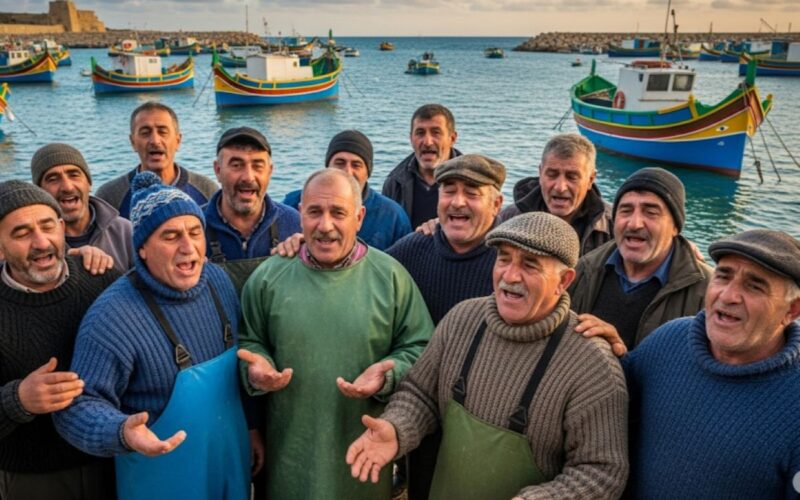Why did you set up the group?
“For many years my husband David and I participated in the Gozo Acoustic Music Sessions: sadly these don’t happen very often now and we missed singing. We live mostly in Gozo but spend some time at our house in Somerset in South West England, where the popular monthly Sea Shanty nights at Pebbles Tavern in Watchet gave us the idea for Gozo Sea Shanty Nights.”
Who can be part of it?
“The great thing about Sea Shanties is everyone can join in. You don’t have to be a great singer. Shanties are “call and response” songs. The caller sings a line and the rest of the group respond and/or the caller sings the verse and the group sing the chorus. Song books are provided.”
Why is the setting for the group just right?
“The Crab Shell Kiosk at Xwejni Bay is the perfect location for us. It’s informal, located just above the beach with fantastic views of the sea, and Chris and his team are very welcoming.”
Tell us more about the songs themselves
“Sea shanties are traditional songs historically sung by work gangs of sailors on sailing ships, although nowadays a broader definition includes a variety of ‘songs of the sea’.”
“For people coming along to the Crab Shell, some shanties will already be familiar from school (What Shall We Do With The Drunken Sailor), or pop adaptations (The Sloop John B), or post-match singsongs (The Wild Rover), or Covid on-line hits (The Wellerman), or films (The Fisherman’s Friends).”
“There is a strong sea shanty tradition in the UK and similar songs have been sung by the sailors of other maritime nations. The most famous Maltese shanty, “The Ballad of Sammy’s Bar”, was written by English singer-songwriter and sailor Cyril Tawney when he was stationed in Malta. It tells the story of a young man in love with a Maltese girl but her head is turned by the Yankie car driven by his rival Johnny, with tragic consequences.”
I went down to Sammy’s Bar
Hey, the last boat’s a’leavin
By the shore at Pieta
Haul away the daighsoe [sic]
On his website, Tawney explained that Sammy’s Bar was one of several songs concerning unrequited love which he wrote in the late 1950s: “For me and several of my fellow-submariners in Malta in the mid-50s, love hadn’t been too kind, and in this particular song I thought we’d all feel a lot better if I had the girl killed off in a car crash!” he says.
The song centred around a popular submariners’ rendezvous close to the Submarine Depot ship, HMS “Forth”, tied alongside in Msida Creek. It was actually called The Old Bar but always known as Sammy’s Bar, after the proprietor who, apparently, sold a very cheap and nameless rough, white wine in fivepenny or tenpenny measures, and even with hardened drinkers it was customary to dilute it with lemonade. Surprisingly, however, it had also been patronised by Royalty when Princess Elizabeth and Prince Philip were stationed in Malta a few years earlier, so it had become an ‘in’ place for the ‘top people’ to go slumming.
The bar was little more than a hole in the wall, Tawney continues, and would be full with a couple of dozen punters, yet it had good acoustics and so he headed there with his guitar.

“Sammy’s Bar was deliberately written in shanty form of the type that has a two-line refrain spliced into two-line stanzas,” he explained. “To appreciate the predicament of the fellow in the song, you need to know the importance of the car hire business in Malta at the time. The buses were grubby bone-shakers, and you wouldn’t impress a girl by taking her on one of those – besides which, buses would only take you to the popular overcrowded beaches. To get to the more secluded parts of the island, a car was essential. If you had the money, you could hire some marvellous cars, real American limousines with electrically controlled windows and so on, but these were generally beyond the means of an ordinary matelot. The basic situation in the song, then, is that two lads are after the same girl, but one of them earns more money than the other and can afford to hire a ‘Yankee car’. Many people have mistakenly assumed that one of the rivals is an American and the other British, but that isn’t the case—they’re both British.”
“As a young man about this time, I got it fixed in my head that all girls were fundamentally gold-diggers. It was easy to get that impression in Malta, because available men outnumbered the Wrens by a colossal proportion, with the result that a large number of these hoity-toity young ladies wouldn’t be seen dead with anything other than an officer.”
However, the girl in the song is more interested in impressing her friends than in making a comparative assessment of the young men’s qualities – and later, Tawney says, he realised there are also women ‘who are prepared to endure protracted penury for their chosen man’.
“The car crash [described in the ballad] actually happened to me, not to any girlfriend, and it was a ‘Yankee car’. It wasn’t hired; it belonged to a US Navy friend stationed at an airbase. The accident wasn’t serious, no-one was injured, but it was my first car crash and it made a long-lasting impression on me. It was still on my mind when Sammy’s Bar came to be written, hence the woman comes to a tragic end in that fashion.”
Anyone is welcome to head down to Xwejni and enjoy an evening belting out sea shanties, for free – all we ask is that you drive carefully en route!
The next sea shanty night is scheduled for Tuesday August 19.
For more information and future events see Facebook group Gozo Sea Shanty Nights.










